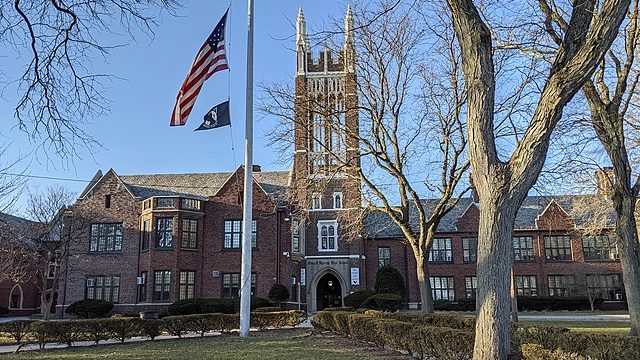
As debates over originalism and legal conservatism continue to develop, and as calls for the Supreme Court to overrule its abortion precedents grow in volume, this James Wilson Institute Symposium on the school-prayer decisions is occurring at an ideal time.
The previous Symposium essays have made valuable contributions to the debate, and I have learned from all of the authors, but they all overlook three important topics at the core of the school-prayer controversy: the consolidation of judicial power under the “incorporation” doctrine, the reasons why the school-prayer decisions will not be overruled, and the relevance of demographic and cultural factors in driving shifts in American church-state law.
Incorporation, Federalism, and Judicial Power
In the three Symposium essays submitted so far, the authors either neglect the incorporation issue or treat it as a peripheral matter. Indeed, Keisha Russell ignores the subject altogether. Professor Francis Beckwith devotes a mere parenthetical to incorporation: “I am assuming, for the sake of argument, that the incorporation of the Establishment Clause through the 14th amendment is unproblematic.” Although Gunnar Gundersen does question whether incorporation is in fact problematic, noting that “it makes no sense to incorporate a limitation on the federal government that exists for the benefit of the states against the states,” even Gundersen does not seem to believe that incorporation lies at the heart of the school-prayer controversy.
The incorporation doctrine, however, is not a mere historical footnote. Besides the obvious problems, from an originalist standpoint, with incorporating the Establishment Clause (which was designed, as Gundersen notes, to protect states from federal intrusion on religious matters), there are deeper problems raised by this issue – problems that lie at the core of how the Supreme Court operates in our political system.
The combination of judicial supremacy with the broad language of the Fourteenth Amendment has made the Supreme Court the most powerful institution in our polity, so that just about all political disputes can become subject to Supreme Court review and oversight. At the same time that the Supreme Court has become the most powerful American political institution, it has also become the least representative. As Justice Scalia keenly observed in his Obergefell dissent, “Four of the nine [Justices] are natives of New York City,” and the Obergefell Court had not “[n]ot a single evangelical Christian … or even a Protestant of any denomination.”
Incorporation of the Establishment Clause, in other words, means that nine elite lawyers with very little connection to or understanding of vast portions of the nation will be making decisions for millions of children about how their school day begins. The consequence of this paradigm, as I wrote in a recent piece on why state courts matter, is “that all the public schools in the nation would be tugged by the gravitational pull of the nation’s most secular elements,” so that “the most Christian parts of the country, namely the American South, would be subject to the cultural norms of New York City.”
It is also worth noting that the neglect that authors Beckwith, Russell, and Gundersen show for incorporation is in sharp contrast with how leading conservative thinkers responded to the school-prayer cases when they were decided. On this point, consider how, immediately following the school-prayer cases, two National Review founders, Willmoore Kendall and Brent Bozell, mounted powerful attacks against the decisions, and each focused on the incorporation issue.
In 1964, Professor Willmoore Kendall (William F. Buckley’s professor at Yale and mentor on constitutional matters) wrote a long Modern Age essay, “American Conservatism and the ‘Prayer’ Decisions,” in response to the Engel and Schempp decisions. The essay was so influential that it was cited extensively in the Congressional Record that year by Representative James B. Utt. Nearly 50 years later, Professor George W. Carey (one of the leading constitutional conservatives of the 20th century) wrote the following about Kendall’s school-prayer essay: “I know of no writings (and we have been flooded with them over the years) that simultaneously bring us to the issues at stake, state the conservative alternatives on these questions, and reflect the depths of conservative outrage concerning the course of events, a course dictated, no less, by the imperious masters of the American liberal establishment.”
What distinguishes Kendall’s essay is that it did not simply argue that Engel and Schempp were wrong merely because they were based on the Warren Court’s misapplication of the Establishment Clause to school prayer. Rather, Kendall wrote, “[t]he real significance and danger of the ‘prayer’ decisions lies … in the attempt to lay down a general [national] rule on religious observances in the schools where formerly there was none.” The school-prayer decisions thereby displaced the basic norm at the core of our constitutional order – the norm that empowers “the local community [to] work the matter out, as part of their general problems of living together on their little portion of American real estate.”
Kendall admonished legal conservatives not to counter the school-prayer cases by accepting the Supreme Court’s Fourteenth Amendment incorporation project and then “frittering away our energies in argument with the Supreme Court” over “the so-called ‘broad’ interpretation versus the so-called ‘narrow’ interpretation” of the Establishment Clause. This submission to incorporation of the Establishment Clause, Kendall argued, would only serve to legitimize, and thereby extend, the Court’s role in arbitrating church-state affairs at the local level, a power that the Constitution did not give the Supreme Court.
Two years after Kendall’s essay, L. Brent Bozell II (Buckley’s brother-in-law and co-founder of National Review) published The Warren Revolution (1966). In this nearly 400-page critique of the Warren Court, Bozell identified four areas of law in which the Warren Court had initiated a revolution against the American constitutional order, and one of these areas, according to Bozell, was in the realm of school prayer. Like Kendall, Bozell focused on incorporation, devoting several pages to why “even if it were true that the Framers of the Fourteenth [Amendment] intended to make all of the rest of the Bill of Rights applicable to the States … such a conclusion is absurd in the case of the [E]stablishment [C]lause.”
Both Kendall and Bozell understood that a Supreme Court that oversees state involvement in religious affairs will inevitably take on the role of managing public schools – dictating which subjects may be taught, where public school teachers may offer instruction, and yes, how the school day may begin. When we debate Engel and Schempp but ignore the incorporation issue, we are betraying the origins of legal conservatism – and more importantly, we are betraying our constitutional order.
Why Won’t Engel and Schempp Be Overruled?
All three Symposium authors take for granted that Engel and Schempp will not be overruled. As Beckwith accurately summarizes public opinion on the matter, “there is a general sense that Engel and Schempp are settled law, that it is highly unlikely that the current Court, even with its 6-3 originalist majority, would even entertain overturning those precedents.”
I agree with Beckwith that this is the “general sense,” but none of the authors explores why this is so. At the outset, we should acknowledge that the fact “there is a general sense that Engel and Schempp are settled law” has little to do with stare decisis. As political scientists have demonstrated, stare decisis exerts limited force on Supreme Court decision-making. Indeed, many scholars are predicting that the Court will overrule some (or even all) of its abortion precedents in the Dobbs case.
Nor is the Court’s unwillingness to overrule Engel and Schempp a product of Supreme Court composition, at least not in a partisan or ideological sense. Six of the nine sitting Justices have been appointed by Republican presidents. Unlike prior Republican nominees, all six of the current Republican-appointed Justices have been exhaustively vetted for their conservative credentials and also have been given the stamp of approval by the Federalist Society.
So why, if we think this Court might take the bold step of overruling Roe and Casey, do we agree that this Court will not do the same with Engel and Schempp?
Just as the answer does not lie in stare decisis, it does not lie in originalism. As Beckwith correctly notes, the fact that the current Court has a 6-3 originalist majority does not make it likely that this Court will overrule Engel and Schempp. But why is this so? Just about no serious originalist believes that the Establishment Clause forbids government-led prayer. Indeed, even if one accepts the incorporation of the Establishment Clause through the Fourteenth Amendment – a big “if,” as suggested above – school prayer is still an easy case for originalists, given that government-led prayer in public schools was a common practice during ratification of the Fourteenth Amendment and school prayer continued to be a pervasive part of American public education for nearly 100 years after that point. If these six “originalist” Justices are unwilling to overrule Engel and Schempp, it is not because of originalism.
There is something else – something besides stare decisis, judicial politics, and originalism – that explains why we all know that Engel and Schempp will not be overruled.
Form and Matter
The Supreme Court will not overrule Engel and Schempp because the nation has itself changed. Here, it is useful to consult Hillsdale Professor Thomas G. West’s theory of “form and matter” in explaining our constitutional order. In West’s outstanding book, The Political Theory of the American Founding: Natural Rights, Public Policy, and the Moral Conditions of Freedom (2017), West explains how “natural rights and the laws of nature are the form of the founding, and the facts of colonial America are the matter.” According to West, “[b]oth of them together – matter shaped by form – produced the American regime.”
What West does not explore in that book, however, is that when matter changes, form follows. So, although West may be right that the Founding consisted of a form shaping the matter, what we have today is the converse: a form that has been shaped by matter. In other words, we now have a different form of law because we now have a different people.
To see how matter shapes form in the context of public religious displays, consider two 21st century controversies in this area: Town of Greece v. Galloway (2014) and McCreary County v. ACLU of Kentucky (2005).
The Town of Greece case involved whether a town in upstate New York violated the Establishment Clause by beginning its monthly meetings with a prayer by a local clergy member. The Supreme Court upheld the practice, on the basis that the Court had permitted similar state legislative practices in Marsh v. Chambers (1983), and the town made an effort to include various faiths by inviting “a Jewish layman and the chairman of the local Baha’i temple.”
Justice Kagan dissented, however, because the town invited mostly Christian clergy members and the prayers were thus principally Christian in content. Justice Kagan insisted the town could have prayers only if they were denominationally neutral – meaning that the prayers must be watered-down so as to be framed “in nonsectarian terms, common to diverse religious groups,” or they must take turns so that “one month a clergy members refers to Jesus, and the next to Allah, or Jehovah.”
Much of Justice Kagan’s opinion rested on what diversity compels of constitutional law. She scolded the majority for being insensitive to the difficulties of accommodating “the multiplicity of Americans’ religious commitments.” As Justice Kagan put it, faith is “a core aspect of identity.” Government-sponsored prayer therefore “carr[ies] the ever-present potential to both exclude and divide” a diverse population, thereby challenging “the project – the distinctively American project – of creating one from the many, and governing all as united.” Permitting one faith to be aligned with the town is not permissible because “[t]hat is not who we are.”
Justice Kagan’s dissent gets at a fundamental truth about incorporating the Establishment Clause in modern-day America. Because incorporation means that what obtains for our most diverse big cities must also obtain for our most homogeneous small towns, school prayer cannot be permissible – anywhere
We can also see the role of matter in shaping form in what is otherwise a very different type of dissenting opinion – Justice Scalia’s dissent in McCreary County v. ACLU of Kentucky (2005). In that dissent, Justice Scalia objected to the majority opinion holding that a public display of the Ten Commandments in a Kentucky courthouse violated the Establishment Clause. Justice Scalia argued that the Kentucky display should be permissible, just like the Ten Commandments monument upheld in the companion case, Van Orden v. Perry (2005), because both displays were consistent with the nation’s tradition of endorsing monotheistic messages that are “scrupulously nondenominational.” Justice Scalia linked this monotheism principle with the then-current demographics of the nation, pointing out how “[t]he three most popular religions in the United States, Christianity, Judaism, and Islam – which combined account for 97.7% of all believers – are monotheistic.”
Putting aside the questionable sociology and statistical reasoning underlying this claim (can we say that Christian displays are constitutional because Christians constitute roughly 95 percent of American believers, or that Christian-Buddhist-Hindu displays are constitutional because these three groups combine to account for 97 percent of all American believers?), there is something profoundly revealing about the relationship between form and matter in Scalia’s monotheism principle. As Justice Stevens observed in his Van Orden dissent, the “inclusion of Jews and Muslims inside the category of constitutionally favored religions surely would have shocked Chief Justice Marshall and Justice Story.” And even if we dismiss Founding Era views on the matter as being displaced by the Fourteenth Amendment, it is still hard to reconcile Justice Scalia’s monotheism principle with the indisputable fact that, well after the passage of the Fourteenth Amendment, in Justice Stevens’s words, “many accepted the idea that America was not just a religious nation, but ‘a Christian nation,’” as the Supreme Court explicitly asserted in Church of Holy Trinity v. United States (1892).
That a non-originalist like Justice Kagan and an originalist like Justice Scalia reasoned in essentially the same way – constructing a constitutional principle from contemporary demographics – reveals the power of matter in shaping form. This power of matter is what I believe makes Engel and Schempp “settled law.” Just as it was unimaginable that the Court would interpret the Establishment Clause to ban school prayer when this was putatively a Christian nation, it is unimaginable that the Court will interpret the Establishment Clause to permit school prayer now that our nation is no longer a Christian nation. Constitutional form is driven by, in Justice Kagan’s words, “who we are” – not who we were.
Conservatism in a New America
We lawyers sometimes like to think of the courts as leading the nation in resolving (or creating) societal problems. Whether a product of professional hubris or vocational narrowness, this often is the way we look at American politics. So conservative lawyers naturally look at the Warren Court as having created many of the problems we observe. Look at how secular the country has become! Look at the state of our public schools! Engel is to blame!
There is, to be sure, some truth in this account, but there is more truth in viewing the Engel decision as a product of a nation in flux. Put differently, Engel did not create the problem; rather, the problem created Engel.
This, I submit, is why we all know that Engel will not be overruled – regardless of stare decisis, originalism, and the composition of the Supreme Court. Asking for Engel to be overruled is akin to asking for another country.
The task for conservative legal scholars and advocates, and for conservatives in general, is figuring out how to make our Founding ideals work in this America. That will require getting over our bad habit of thinking that because a particular Supreme Court decision got the law wrong, we can fix the problem by getting the Court to get the law right. We cannot restore a pre-Engel America by overruling Engel. What we can do, however, is sustain our Founding ideals through a better legal conservatism – one that seeks to empower federalism and local governance, to restore the freedom of association and religious liberty, and to strengthen our support structures and mediating institutions. These tasks, I believe, will be the defining challenge for conservatives in the 21st century.





